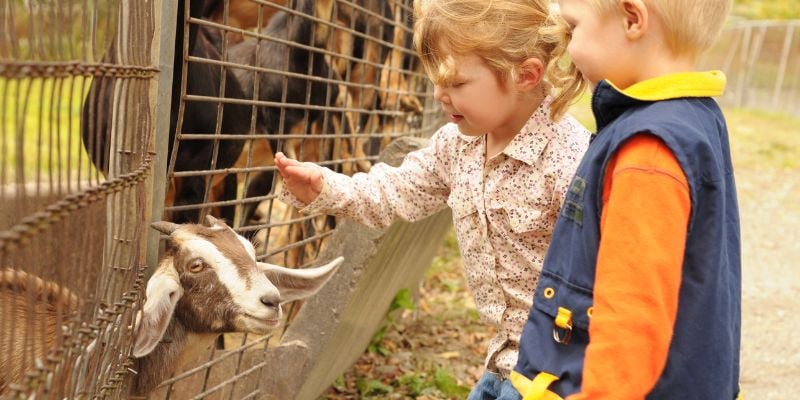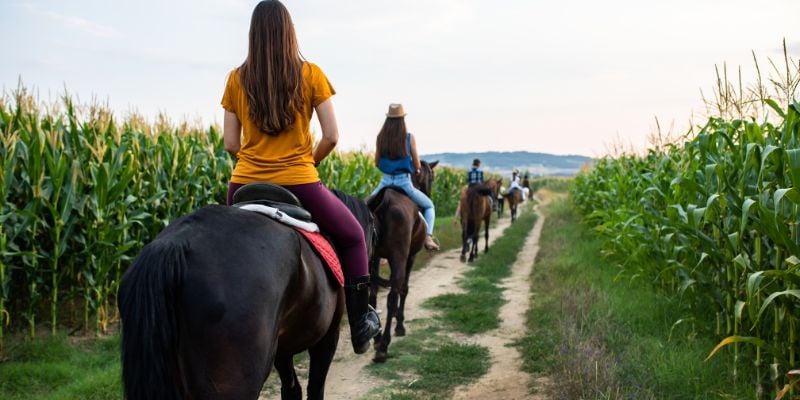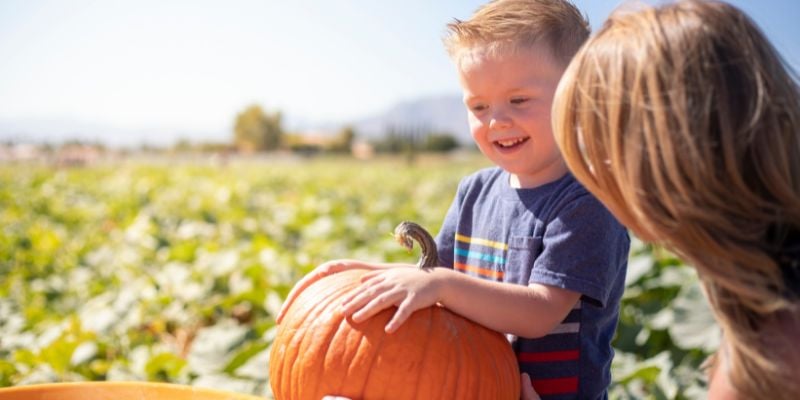Pumpkin patches. Corn mazes. Hayrides. Petting zoos and horseback riding.
Farms offer a unique setting for a variety of events that combine education, entertainment, and agriculture. We call these events agritainment: it’s a form of agritourism that offers visitors a chance to experience the farming lifestyle and learn about agriculture in an engaging and interactive way. The goal of agritainment is to provide visitors with a fun and educational experience that connects them with the land, the people who work it, and the food that is grown there.
Farms can host a wide range of events that offer visitors a chance to experience agriculture and the farming lifestyle. Some of the most common events held on a farm include:
- Harvest festivals: These events celebrate the fall harvest and typically feature pumpkin patches, corn mazes, hayrides, and farm-to-table food options.
- Farm-to-table dinners: These events showcase local food and offer guests a chance to dine on the farm.
- Educational farm tours: These tours offer visitors a chance to learn about farming practices and get a behind-the-scenes look at how food is grown.
- Petting zoos: These events offer children a chance to interact with farm animals such as goats, chickens, and cows.
- U-pick events: These events allow visitors to pick their own fruit or vegetables directly from the farm.
- Agricultural fairs: These events showcase the best of local agriculture and typically feature livestock competitions, farm equipment displays, and agricultural education exhibits.
- Wine or beer tastings: Some farms produce their own wine or beer and host tasting events to showcase their products.
- Seasonal events: Farms may also host events that celebrate specific seasons, such as spring planting or winter holidays.
How to Plan an Agri-tainment Event at Your Farm: A 17-Step Checklist
1.Identify Your Event Objective
Determine what you want to achieve with the agri-tainment event. Maybe you have a plot of land that’s only used for part of the year and want to use it to generate income during the off-season. It could be to promote a specific product or service, like the artisan jams or pies you might produce. Or your objective might be to generate awareness or to create a fun experience for attendees. Whatever your goals, defining your event’s purpose will help you make decisions and stay focused throughout the planning process.

2. Choose the Location
Identify a suitable location on your farm for the event. Consider factors such as accessibility, availability of amenities, and suitability for the type of event you want to organize. Make sure you think through issues like parking and restrooms. (Here are five key boxes you should check when selecting your venue.)
Time of year and weather should factor into your decision, too. For summer events, try to include some shaded areas so your guests can escape the sun. Plan for rainy skies as well: will you have an indoor or covered area?
3. Define Your Target Audience
Who do you picture attending your event? Is it designed for families with small children, or adults in their 30s and 40s with disposable income? Defining your target audience will help you in planning the activities, marketing the event, and creating a memorable experience.
4. Decide on the Date and Time
Agritainment events can take place at any time of the year, and range from single-day activities to weeks-long festivals. Consider factors such as the weather, holidays, and other competing events when you set the date and time for your event.
If you’re opening a year-round attraction or experience, you’ll still want to decide on operating hours and which days of the week you plan to be open.
5. Develop a Budget
A budget is an incredibly useful tool that can help you stay on track as you plan your event (and can sometimes make decisions easier, not harder). Start by determining your expenses; consider all costs such as venue, equipment, personnel, marketing, and entertainment.
Then, estimate how much revenue you expect to generate. Most events rely on ticket revenue to cover their costs and generate a profit. But there are other ways you can earn revenue, too, such as merchandise and concessions sales.
Need some help creating your budget? Follow our step-by-step guide to manage your event budget like a pro.

6. Plan the Agritainment Activities
Agritainment events often have multiple different amusements within a single location. For example, maybe your corn maze is the main attraction, but kids can also enjoy climbing a hay mountain or jumping in the corn pit.
Whatever your individual setup looks like, create a detailed list of activities for your event. This could include games, contests, live music, demonstrations, and educational sessions. Don't forget about things like your gift shop or concessions. Many folks attend agritainment events specifically to shop for farm-fresh produce and artisan goods, or to try homemade treats.
7. Create a Marketing Plan
Guests won’t magically find your event on their own; you need to promote it!
Develop a marketing plan to promote your agritainment. Consider using a mix of traditional and digital marketing channels to reach your target audience.
Not sure where to start? Here are a few guides that can help:
- 11 Simple Ways to Promote Your Event and Increase Ticket Sales
- 7 Tips to Promote Your Event on Social Media
- How to Use Influencer Marketing to Promote Your Event
8. Hire Personnel
Even the most experienced event organizers can’t do it all on their own. You can only succeed if you have a solid team to support you.
Every event has different roles that need to be filled, such as logistics coordinators, marketing and communications specialists,security personnel, vendors, entertainment, and production staff. Identify the key roles that will be required for your event and determine the number of personnel required to manage the event.
9. Arrange for Equipment and Supplies
You probably already have all the equipment you need for the business of farming, but hosting an event for guests might require some new supplies. This could include tents, tables, chairs, audio-visual equipment, and decorations. You may need additional wagons to transport guests around the farm, or signage to direct everywhere to the various activities you have to offer.
Identify the equipment and supplies required for your event. Start looking for vendors early, so you have time to negotiate the best price and to make sure you have everything you need.

10. Plan for Food and Beverage
Let your event theme and the seasons guide the food and beverage options you offer. Nothing says fall like cider and donuts. Fresh-squeezed lemonade and fruit pies are perfect for summer.
Consider partnering with local food vendors or offering farm-to-table options. If your farm specializes in a particular food or beverage item, this is the right time to showcase it.
11. Obtain Necessary Permits
Obtain any necessary permits and licenses for the event. This could include permits for food handling, alcohol service, amplified sound, and music licensing.
If you’re new to this process, check to see if your town has a chamber of commerce or small business association. They can be a wonderful resource for details on the local permit requirements. There may even be a dedicated small business liaison who can walk you through all the paperwork.
12. Develop a Backup Plan
It’s important to prepare for the unexpected, especially when you’re planning an event on a farm. Create a contingency plan in case of unforeseen circumstances such as bad weather, equipment failure, or other emergencies. Start by reviewing this list of five common challenges that can pop up at your event and how to handle them.
Communication is key when things don’t go as planned. Make sure you know how you’ll let guests know about any changes if the need arises.
13. Create a Schedule
Event days are hectic. It’s easy to let things fall through the cracks when you’re being pulled in a million different directions.
Develop a detailed schedule for the event in advance so you don’t have to rely on your memory alone when it’s “go” time. This should include the start and end times for each activity, breaks, and time for setup and cleanup. You may also want to add when team members need to arrive, when vendors are scheduled to be on site, and when the doors open for guests.

14. Train Personnel
A smooth event doesn’t happen by accident.
Provide your team with the training and resources they need to perform their jobs effectively. This could include training on event planning and logistics, marketing and communications strategies, and technical skills such as audio and lighting setup.
You’ll also want to train everyone on your business policies and practices, as well as some soft skills like how to communicate effectively with your guests.
15. Set Up Your Ticketing
One of the most critical aspects of planning is selling tickets. This is how your event makes money!
Determine what types of admission you want to offer, for example, one price for access to every activity within your event or individual tickets for each attraction. Then, set your ticket price.
Finally, you’ll want to choose your ticketing software. Look for a platform that offers customizable ticketing options, easy payment processing, and low fees. And make sure it has the features you need and can support the types of tickets you want to sell.
Need some help choosing the right ticketing platform for your agritainment event? Ask these 20 questions when choosing an event ticketing platform.
Curious how Passage can help your agritainment event? Schedule a demo with one of our event experts, or start creating your first event now - it's FREE!
16. Conduct a Rehearsal
Practice makes perfect, so provide opportunities for your team to practice their skills and receive feedback on their performance. Mock events and simulations can help smooth out any bumps before guests arrive.
Conduct a rehearsal of your event to ensure everything runs properly. Run a few test transactions on your ticketing software or point of sale system. Invite your entire team on a hayride so they can get the guest experience first hand and identify anything that needs to be fixed before the big day.
17. Evaluate Your Event
After your event ends, evaluate its success. Collect feedback from attendees, staff, and vendors to gain insights into what worked well and what can be improved upon in the future. This could include feedback forms, surveys, and focus groups.
Based on your data and feedback, identify the strengths and weaknesses of your event. This will help you understand what to replicate in the future and what to improve upon. Debrief with your team and identify how you could improve the event format, marketing strategy, or logistics planning.
Your event doesn’t need to be perfect the first time around. If you listen to guest feedback and make adjustments where you can, it will get better and better over time.
Final Thoughts
Hosting an agritainment event can offer many benefits for farmers, communities, and visitors alike. It can provide an additional source of revenue for farmers, help build community, and strengthen relationships between farmers and consumers. Agritainment also provides an opportunity for visitors to connect with farmers, learn about agriculture, and develop a deeper appreciation for the work that goes into producing food.












